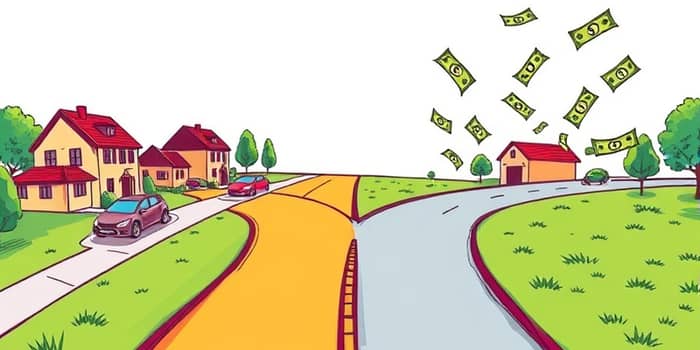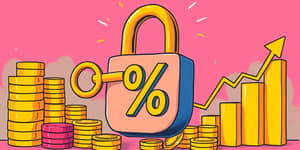Every time you consider borrowing money, a critical decision awaits: choose between secured and unsecured loans. Each path offers distinct advantages and challenges, impacting your costs, risks, and approval odds. With the right information, you can align your borrowing strategy with personal goals, whether you are buying a home, consolidating debt, or covering unexpected expenses. This article explores core distinctions, real-world examples, pros and cons, and practical tips to help you make an informed choice.
What Are Secured and Unsecured Loans?
At its essence, a secured loan is backed by collateral—an asset you pledge as security for the borrowed funds. Collateral can include real estate, vehicles, investments, or cash deposits. Should you default, the lender is legally entitled to seize this asset to recover losses. This backing reduces the lender’s risk and often results in more favorable loan terms. Common instances of secured loans are mortgages, auto loans, and home equity lines of credit (HELOCs).
In contrast, unsecured loans rely solely on your creditworthiness, evaluated through credit scores, income statements, and debt-to-income ratios. There is no physical asset on the line, so lenders protect themselves by imposing higher interest rates and stricter requirements. Popular unsecured products include credit cards, personal loans, and federal student loans. If you default, lenders cannot immediately seize property, but they can pursue collections or legal action, which can severely damage your credit profile.
Comparative Feature Analysis
Understanding the tangible distinctions between secured and unsecured loans is crucial. Below is a side-by-side comparison of essential features.
Reviewing this table highlights why lenders offer lower rates on secured loans: they can offset potential losses by liquidating collateral. Unsecured loans fill an important gap for borrowers without property to leverage, but come at a higher cost.
Interest Rates and Loan Amounts
Secured loans frequently begin at interest rates as low as 6.74% APR, depending on market conditions and collateral type. For instance, a homeowner tapping equity at these rates can finance substantial renovation projects or debt consolidation at minimal cost. Vehicles, jewelry, and investment accounts can also act as leverage, though appraisals may introduce additional fees.
Unsecured loan rates vary widely based on credit quality. As of mid-2025, rates can range from 6.49% for top-tier borrowers up to 35.99% APR for those with borderline credit. Lenders assess your credit score, employment history, and existing debt to set rates. The typical unsecured personal loan caps at around $100,000, though most borrowers secure smaller amounts, often between $5,000 and $50,000. This dynamic underscores the importance of improving credit health before securing large, unsecured financing.
When weighing costs, ask yourself: Is it worth pledging an asset to unlock lower interest rates and larger amounts? Or do you prefer an unsecured arrangement to maintain peace of mind with no collateral? Your decision should match your financial goals and tolerance for risk.
Pros and Cons: A Closer Look
Both loan types bring opportunities and trade-offs. Delving into their advantages and disadvantages can clarify which aligns with your needs.
- Secured Loans Pros:
- Lower interest rates compared to unsecured options
- Potentially higher borrowing limits based on collateral
- Easier qualification for borrowers with imperfect credit
- Secured Loans Cons:
- Risk of losing your collateral in the event of default
- More extensive paperwork and appraisal requirements
- Temptation to borrow more than necessary
- Unsecured Loans Pros:
- No asset risk; collateral remains safe
- Fast approval and fund disbursement
- flexibility to use funds freely without restrictions
- Unsecured Loans Cons:
- Generally higher interest rates and fees
- Lower maximum loan amounts
- Strict credit score requirements
Qualification and Application Process
The path to approval differs significantly between secured and unsecured loans. Secured loans necessitate documentation to confirm collateral ownership and value. A lender may require property deeds, vehicle titles, or investment statements, and often an independent appraisal. A credit check is still standard, but the reliance on collateral can mitigate lower credit scores.
Unsecured loans hinge on creditworthiness. Lenders examine credit reports, verify income through pay stubs or tax returns, and calculate your debt-to-income ratio. A strong employment history and clear credit score (above 700) boost approval odds. Online lenders increasingly automate this process, offering near-instant decisions. However, rapid approval may come at the cost of higher rates, so comparison shopping is essential.
Use Cases and Real-World Applications
Secured loans are ideal for substantial, long-term investments. For example:
- Home purchases: Mortgages spread out payment for a lifetime asset.
- Auto financing: Car loans let you drive a new vehicle with manageable monthly payments.
- Home improvements: HELOCs tap into equity for renovations that elevate home value.
Conversely, unsecured loans suit short-to-medium term needs:
- Debt consolidation combining high-interest balances into one payment.
- Emergency expenses such as medical bills when you lack sufficient savings.
- Education and professional development when federal or employer funding falls short.
In each scenario, align your loan choice to both the urgency and scale of funding you need. Borrowing responsibly means setting realistic repayment goals and avoiding overleveraging your assets.
Key Considerations and Final Advice
When deciding between secured vs. unsecured loans, reflect on these critical factors:
- Whether you have valuable assets to pledge as collateral
- Your current credit score and overall financial health
- Your tolerance for potential asset loss in a worst-case scenario
- Estimated duration of the loan and cash flow for repayments
Before signing any agreement, obtain quotes from multiple lenders, read the fine print, and scrutinize fees such as origination costs, prepayment penalties, and late payment charges. Remember, both loan types report to credit bureaus—consistent on-time payments can build your credit, while missed deadlines can inflict long-term damage.
Conclusion
Secured and unsecured loans each serve distinct purposes. Secured loans deliver lower rates and larger loan amounts at the cost of risking collateral, while unsecured loans offer no collateral requirements in exchange for higher rates and stricter credit standards. By evaluating your financial goals, asset base, and risk appetite, you can choose the loan that best aligns with your needs.
Take time to prepare: improve your credit score, gather necessary documents, and compare offers. With these strategies, you’ll navigate the lending landscape confidently, securing funds to support major investments or manage unexpected expenses without compromising your financial stability.
References
- https://www.bankrate.com/loans/personal-loans/secured-vs-unsecured-personal-loans/
- https://www.wellsfargo.com/personal-loans/rates/
- https://www.transunion.com/article/unsecured-vs-secured-loans
- https://www.lendingtree.com/personal/
- https://www.investopedia.com/secured-vs-unsecured-loans-7558592
- https://www.bankrate.com/loans/personal-loans/rates/
- https://www.onemainfinancial.com/resources/loan-basics/whats-the-difference-between-a-secured-and-unsecured-loan
- https://www.afbank.com/article/comparing-secured-loans-vs-unsecured-loans










